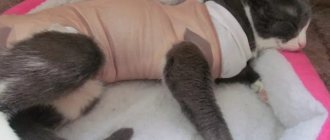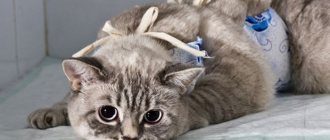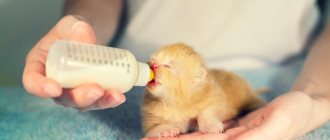Unfortunately, pets get sick in exactly the same way as people. It also happens that a four-legged friend requires the help of a surgeon and an operation that takes place under general anesthesia. How to care for a cat after anesthesia to alleviate the animal's suffering?
Before taking your furry pet to the clinic for a planned or emergency operation, you need to prepare a special place for it so that you don’t have to fuss around with the exhausted cat. It is very important not to feed your pet for 12 hours before surgery so that he does not vomit during the operation and after it under the influence of anesthesia.
How long does it take for a cat to wear off anesthesia after sterilization?
The cat's condition after surgery varies greatly depending on the type of anesthesia. After inhalation (gas) anesthesia, the pet is returned to its owners in full consciousness. Cats recover very quickly after intravenous administration of propofol. It takes them about half an hour to wake up. Therefore, in this section I will talk mainly about intramuscular anesthesia. Usually this is a combination of a muscle relaxant (xylazine/domitor and their analogues) and zoletil. Some doctors use a drug that takes the cat out of medicated sleep. Antisedan removes the domitor effect, and the animal can walk within 30 minutes after the injection.
Cat after sterilization using intramuscular anesthesia
Not all experts yet have an anti-sedan available. Some people simply save money on it (“and so it will wake up”). Others follow the lead of the owners, who find it more convenient to take home a “rag” rather than a meowing cat that is trying to get out of the carrier. All this is unacceptable!
Find out in advance what kind of anesthesia your cat will be given. If after sterilization she is unconscious, it is better to leave her in the hospital under observation for several hours.
Not every clinic has equipment for inhalation anesthesia.
Complications
No animal is immune from complications after anesthesia. The following symptoms may occur:
- Increased pressure;
- Decreased liver function;
- Allergic reaction;
- Intermittent pulse.
In order to reduce the risk of such side effects, veterinarians recommend using gas anesthesia as it is safer.
As a result of an incorrectly performed operation, a complication such as a hernia may occur.
Anesthesia is an integral part of surgical operations. With proper care, the cat quickly recovers, so the owner must know how to properly look after the animal after anesthesia.
If you want to ask a question, please ask in the comments.
Before taking your cat for sterilization surgery, you should be aware that after the intervention, the animal’s body temperature may decrease. To do this, it is necessary to provide the patient with warmth by placing a warm towel or felt flap under her.
How to help your cat recover from anesthesia
Let's consider a situation in which you were given a cat under deep anesthesia. She already twitches her ear if you blow into it, but she can’t blink or walk yet. Paws and ears are cold to the touch. This is due to the fact that body temperature during anesthesia decreases by several degrees. Unfortunately, not all doctors use a heating pad during surgery. Therefore, the cat may experience noticeable trembling - it is simply very cold. And the animal needs to be warmed.
If the cat's eyes are open and she is not blinking, then care should be taken to moisturize the cornea. It’s easier to apply tetracycline ointment and “glue” the eyelids together. Cornergel is well suited for moisturizing. You can drip regular saline solution. Often veterinarians will apply eye ointment themselves during surgery, ask your doctor about this. Owners of brachycephalic dogs (Persians, exotics) should be especially attentive. Their bulging eyes are prone to drying out and causing keratitis.
Cats do not close their eyes while under anesthesia
If you hold a cat in your arms, it should lie belly down. One hand under the chest, the other under the butt. To prevent the tongue from sticking and blocking the airway, it is pulled out of the mouth to the side. When the cat is able to retract it on her own, she will do it. Before this, you can gently moisten the tongue with water so that it does not dry out.
Even if the cat was on a fasting diet before surgery, it may vomit during recovery from anesthesia. To prevent her from choking, her head should be turned to one side or hang down freely. You cannot cradle your pet in your arms like a baby doll (back down).
At home, the cat should be placed on its side, in a warm place on the floor (a blanket near the radiator). It is strictly forbidden to place a sleeping cat on a bed or sofa. On the bed - only when the animal can climb there on its own. The cat may not understand where it is and fall awkwardly down.
If the cat was “packed” into a carrier at the clinic, then it is best to leave it there. Place it on the floor and open the door so that your pet can come out whenever she wants.
The carrier should be spacious and rigid, not fabric
Caring for a cat after castration in the first hours
How long do cats recover from anesthesia after castration: how long can they sleep?
After castration, a cat needs special care. Most veterinary clinics provide post-operative hospital services. In a special box with optimal climatic conditions, the operated pet is observed until it completely recovers from anesthesia. Once convinced that the cat’s condition is satisfactory, it is handed over to its owners.
Care in the first hours after castration comes down to monitoring your pets
If such a service is not available in the clinic or castration is performed at home, it is important to follow the following care recommendations:
- To transport a cat after castration, it is recommended to use a loose carrier with a folding top and an absorbent diaper on the bottom. It is forbidden to transport an operated pet in your arms or in a car seat, as when waking up from anesthesia, it can harm itself or its owner. During transportation and further postoperative stay, the cat is placed on its side;
- It is recommended to lay an anesthetized, operated cat on the floor, since when it comes to its senses, it may fall off the table/sofa/bed. A common symptom of anesthesia sleep is uncontrollable urination. Using an absorbent diaper placed on the floor under the pet will make it much easier to eliminate such a nuisance;
- During anesthetized sleep, body temperature drops by 1-1.5°, so to prevent hypothermia, the operated pet is placed next to a heating radiator. It is strictly forbidden to place animals near electrical appliances with an open heating element. Instead of a battery, you can use a heating pad or a plastic bottle with hot, but not boiling water, which is placed next to the cat under a bedding or blanket. It is important that the heat does not come into contact with the cat's perineum, as this will cause bleeding. During the warm season, no additional warming procedure is required;
- for a more comfortable awakening from anesthesia sleep, it is recommended to close the curtains on the windows, since bright sunlight causes irritation of the optic nerve;
- Anesthesia sleep lasts from 15 to 120 minutes. depending on the method of administration and dose of the drug. During this time, it is necessary to monitor the cat so that it does not bury its nose in anything and suffocate. In addition, cats in this condition do not blink, which can cause the cornea to dry out. It is recommended to drip sterile saline solution, contact lens liquid, or eye drops without antibiotics into the eyes several times;
A protective collar will prevent your pet from licking the wound, further irritating it.
- Often waking up after anesthesia causes aggression in the pet. Therefore, it is recommended to provide the cat with complete rest for 24 hours, limiting access to him by other animals or children. It is forbidden to forcefully wake up your pet. Depending on the individual characteristics, after waking up, the cat may experience an unsteady gait, vomiting, involuntary urination, and a lethargic and drowsy state. This condition can last up to 8 hours, which is normal and should not cause concern;
- the wound on the scrotum after castration is not sutured, so it is recommended to minimize the amount of filler in the tray or replace it with absorbent paper. This will prevent the ingress of small filler particles and subsequent complications;
- A few hours after surgery, there may be slight bleeding from the incision, which is normal and safe for the cat. You can lightly dry the wound with a gauze cloth. In case of significant bleeding of more than 1 ml, you should urgently contact the doctor who performed the operation;
- Medicines prescribed by a veterinarian will help relieve pain. You can tell that a cat needs pain medication by dilated pupils, meowing, pursed paws, and aggression when attempting contact;
- You can prevent the possibility of damage to the healing incision by the cat’s rough tongue during hygiene by wearing a protective collar around the neck for several days. Such a product will limit the cat’s access to the wound without affecting food intake in any way.
Note! Veterinarians recommend castration in the fall or winter months, as during this period the likelihood of infection of the incision during rehabilitation is lower.
In the summer, as a preventative measure for infection, the doctor prescribes a 5-day course of antibiotic treatment.
How does a cat behave after anesthesia?
When the cat starts to get up, it may stagger like a drunk and crash into walls and objects. There is no point in holding her in place by force. It is better to limit your pet's movements within one room.
In order for the cat to calmly come to its senses, you need to remove external stimuli as much as possible. When recovering from anesthesia, even the calmest cat can become aggressive or panic. Need to exclude:
- Society of other animals;
- Loud, sharp sounds;
- The light is too bright;
- Drafts, cold;
- Violence in any form (being held in arms, dragged from place to place).
When waking up, the cat does not understand well what is happening around. She feels weak (her legs can't hold her up, her head is spinning). Instinctively, the animal will try to defend itself or run away - just in case. Do not allow children to pet your pet when she recovers from anesthesia, and be careful yourself. Without recognizing your hands, the seemingly sleeping beauty can rise up like a candle and awkwardly fall back.
Sometimes owners are frightened by the vocal exercises of a cat that is just waking up from anesthesia. This may be a hoarse meow, a howling growl or hissing.
Residual effects from anesthesia may last up to a day (usually much less), after which the cat will behave as usual. A short video showing a cat after anesthesia:
Anesthesia and eyes
The cat's body is designed in such a way that while under anesthesia, cats' eyes remain open. This does not mean that the animal can see everything around during the operation.
To prevent the mucous membrane of the eye from drying out, the veterinarian will advise you to buy special eye drops. Not vitamin solutions and medications that relieve redness, but ordinary drops that prevent the cornea from drying out. They need to be dripped into the cat during surgery, as well as periodically during recovery from anesthesia.
When instilling, you need to press the upper and lower eyelids, simulating blinking, because the cat's eye itself will not be able to distribute the solution throughout the mucous membrane.
When can you feed a cat after sterilization?
The sterilization operation is preceded by an 8-10-hour fasting diet. Therefore, when everything is over, the owners cannot wait to feed their pet. However, there is no need to rush: after anesthesia, vomiting is possible.
The doctor should tell you how many hours after sterilization you can feed your cat. Recommendations will vary depending on the type of anesthesia used during surgery. On average, you can offer food through:
- Inhalation anesthesia – 1-2 hours;
- Intravenous anesthesia with propofol - after 2-3 hours;
- Intramuscular anesthesia (Domitor + Zoletil) – after 4-8 hours.
First, the cat is given a small portion of its usual food. If she doesn’t vomit, you can give her more. If you burp, wait a few more hours. Vomiting (one-time) is considered normal within 24 hours after surgery.
Prolonged fasting for cats is neither desirable nor justified! The main criterion is regaining consciousness and restoration of motor functions. If a cat asks to eat, you don’t need to go on a starvation diet for 12-24 hours - this is exactly the advice I’ve seen on specialized forums.
Water can be made available immediately; as a rule, cats do not show interest in it. You cannot force anything into a cat! If he wants, he will drink.
Cornish Rex in a post-operative blanket
What to feed a cat after sterilization and anesthesia
The main mistake of loving owners is the desire to pamper an operated cat with something special. A sudden change in diet can cause digestive upset. There is no need to feed your cat differently after sterilization than before surgery.
If the kitty ate natural food, then the only recommendation is to give the food warm, and not from the refrigerator. You should also avoid products that are strong.
If the cat has been eating dry food, then it is offered when the animal comes to its senses after anesthesia. There is no need to soak the food: the cat had her ovaries removed, not her teeth. However, in addition to crackers, owners often regularly provide canned food from the same company. Then wet food will be an ideal option.
There is no need to run to buy food for sterilized cats immediately after surgery. Hormonal levels will change gradually over 1-2 months. You need to switch to a new food smoothly, after the blanket is removed and the cat has fully recovered.
After sterilization, cats tend to become overweight, but hormonal changes take time
Awakening
In most cases, the cat comes to its senses within 4-6 hours after arriving home. When the cat wakes up, it will immediately try to get up. It is important to ensure that the animal does not harm itself with sudden movements, since some pets immediately try to run away, not understanding the source of the discomfort.
It is important to understand that the behavior of a cat during recovery from anesthesia is an unpleasant sight. The animal looks pitiful, it cannot control its body, and its legs constantly bend. This situation is normal, so you should not try to help your cat unnecessarily. It is better to provide her with peace and monitor her condition.
Some animals may show aggression, this is also normal. The cat does not understand what happened to him and tries to defend himself in the style of a predator - to attack an imaginary offender.
Try not to irritate your pet again. The room should be quiet and calm. Otherwise, the cat will try to hide from intrusive people.
You cannot feed your cat after surgery, but you must give water. To avoid dehydration, start giving your pet water immediately after waking up. In the first hours, she will not be able to drink on her own, so it is necessary to drop a few drops of water into the cat’s mouth every half hour.
There is an opinion that a bowl of water should be left near the bed. However, this should not be done if the owner has the opportunity to water the cat manually. The fact is that a disturbed swallowing reflex will not only prevent the pet from getting drunk, but can also cause the cat to choke or drink through its nose.
Also, the danger of a bowl next to the bed is that the cat suddenly becomes drowsy after anesthesia. He can fall asleep with his face in a cup.
You should not try to feed your cat as soon as she wakes up. The body is still in a sluggish state, so food that is not properly digested can cause constipation. The cat should not be allowed to strain while going to the litter box, as this may cause the seams to come apart.
At first, the cat will not be interested in food. This is fine. Don't try to force feed her. A weakened body will not be hindered by a day of hunger strike.
Feeding can begin only then. When signs of impaired coordination of movements disappear. The first food a cat eats should be liquid. It is important not to offer your cat unfamiliar food after surgery. This should be your usual food at room temperature.
The best option is a lump of pate, which can be offered to the cat by bringing it to its face. For the first time, half a teaspoon will be enough.
You only need to worry if on the third day after the operation the cat does not eat anything. In this case, you need to consult with the veterinarian who performed the procedure.
A cat under anesthesia will walk on its own, so stock up on enough diapers and patience. This situation will last until the pet begins to move. After this, place the tray near the bed so that the patient does not have to look for it.
How long to wear a blanket after sterilizing a cat
The main condition after sterilization is to prevent the cat from licking the seam. To do this, use either an Elizabethan collar or a fabric blanket. The duration of wearing these “accessories” depends on what kind of stitch was applied. You need to focus on the recommendations of the operating surgeon and the condition of the suture, because healing in different animals can occur at different speeds.
If a cosmetic suture was applied (absorbable threads are all inside, the skin is perfectly connected end-to-end), then the blanket is worn for about a week (7 days). I am a reinsurer, so I recommend wearing a blanket for 10 days after surgery.
This is what a cosmetic seam looks like after sterilizing a cat. All the threads are inside.
If the seams are removable, then the blanket is worn until the seams are removed, plus one day after, so that the holes heal quietly after the threads are removed. Usually it is 10-12 days.
This is what a cosmetic stitch looks like on days 10-12
On the first day after surgery, the cat shows little interest in the suture. The worst concern is on the 3-4th day: the shaved fur begins to grow back, and the healing seam begins to itch. The cat may try to lick its tummy through the fabric.
Some cats calmly accept the “clothes” and do not try to take them off. Others roll around and tear at it with teeth and claws until they get rid of it. In this case, it is preferable to wear a collar instead of or together with a blanket.
Instead of blankets, you can wear more beautiful clothes
When a cat first wakes up after surgery, it may back away or walk backwards. Or she completely refuses to get up and walk, as if paralyzed. As soon as you remove the blanket, these frightening symptoms disappear. Check that the blanket is not tied too tightly, and the cat will soon get used to it.
Cats hate blankets, but you have to be patient
General information
Let's start with safety precautions, which must be followed regardless of the circumstances. Whether your cat is recovering from a dental cleaning or recovering from abdominal surgery, she will experience toxicity until she fully recovers from anesthesia.
All drugs for anesthesia are, roughly speaking, drugs that lead to muscle relaxation and temporary cessation of the sensitivity of certain areas of the brain. Often, while under the influence of anesthesia, a cat hallucinates, sees pictures, hears sounds or senses something that is not there. All these oddities can prompt your pet to take unexpected actions. Unfortunately, many owners have learned from their own experience that a cat can cause serious injury to itself after anesthesia.
To avoid obvious risks, you should do the following:
- Do not leave your cat unattended until it has completely recovered from anesthesia! It is necessary! If you need to leave for a short time, your pet should be locked in a carrier. To make it more convenient while the cat is sleeping, do not take it out of the carrier, but simply remove the lid.
- Place the carrier with the cat on the floor to prevent the pet from falling. Falling from a height is dangerous because the impact causes the cat to tense up and the seams may come apart.
- Close all windows and vents - yes, some cats very quickly “drop in” from the windows of multi-story buildings if they imagine something.
- Immediately after surgery, put an Elizabethan collar or blanket on your cat (as recommended by your doctor). You may not even notice your cat has woken up, but owners have learned that cats' sharp teeth can remove stitches in seconds.
Note! Even if the cat has undergone a standard, simple operation, all sterility measures must be observed during the rehabilitation period!
After castration of the cat, make sure that he does not remove the collar and that the tray filler is clean. After sterilizing your cat, stock up on several blankets so that you can change them as needed.
On the first day after surgery, the cat will not be able to regulate its temperature, so it is important to keep it warm. Make sure that the carrier is not in a draft. If paws feel cool, use a heating pad. Woolen fabric or special thermal blankets help preserve body heat. If the cat is constantly losing temperature, it is placed on a heating pad with a temperature of 38–39.5°, covered with a light piece of wool and foil.
Important! While the cat is sleeping, it needs to be turned from one side to the other every 1.5–2 hours, this stimulates blood circulation and reduces the risk of developing edema.
Please note that the residual effect of anesthesia may last a day or more. Delayed intoxication also happens, especially if the cat has liver or kidney problems. You need to keep watch over your pet for at least a day, so you need to ask someone for help in advance. The cat will sleep, but not deeply, she will hear most of the sounds, so it is important not to fuss. Even if you are worried, speak in a confident tone and remain as calm as possible. You need to understand that the cat is in pain and scared, and your confidence will support it. If your pet tries to raise its head or stand up, immediately indicate your presence with your voice. Perhaps the cat does not want to go anywhere, and its attempts to move are associated with a feeling of loneliness and fear.
Important! If the animal has a large stitch on its body, for example, after surgery to remove a tumor, strictly follow the doctor's instructions for changing the bandages. A stale bandage can cause the wound to become infected and cause itching, which encourages the cat to make unnecessary movements.
About a day after the operation, you will be faced with a very important question - what to feed and whether it is possible to feed the patient. Please note that if the veterinarian has indicated that you cannot feed the cat, this recommendation must be strictly followed. For example, after intestinal surgery, even a small amount of food will cause damage to the suture or inflammation. Hunger weakens the body, so to maintain it, the cat is given IVs with vitamin complexes and buffer solutions.
How to treat a seam after sterilizing a cat
Modern standards of veterinary medicine do not require any suture treatment after sterilization of a cat. The tiny cosmetic suture heals on its own; it is not even necessary to remove the blanket within a week after the operation. In the clinic, as a rule, a special spray is applied to the seam and shaved belly:
- Dark gray leather - it was Aluminum spray (Alu-spray, Second Skin);
- Bright green – Terramycin spray;
- Purple – Chemi spray.
The surgical field and suture are treated with Aluminum spray
The seam should be processed only if it is external and removable - the thread knots are visible. And only if the treatments were prescribed by your surgeon. The point is to prevent the threads from sticking to the skin and to each other. Good non-aggressive antiseptics are aqueous Chlorhexidine 0.05% or Miramistin. Using a cotton pad soaked in the solution, carefully remove all crusts and discharge and separate the threads. It is enough to treat once a day. Be sure to remove any stuck-on hair that accumulates in the seam area.
This is what the outer seams look like. Even if absorbable material is used, it is better to remove the threads on the 12th day
Do not use alcohol or drying solutions – Fukortsin, brilliant green – to treat seams. Iodine - only diluted with water 1:1. You should not use any ointments; the seam should be clean and dry.
Removable sutures are removed at 10-12 days. This is a painless and quick procedure. After removing the stitches, the doctor will once again treat the skin with an antiseptic spray and put on a blanket. You can take off your clothes the next day.
Treatment after cat sterilization
If a young and healthy cat was operated on, then no drug treatment is required after sterilization. On the day of surgery, the doctor gives a single injection of a long-acting antibiotic and pain reliever.
If maximum sterility is maintained after surgery, antibiotics are not needed. A clean room, careful preparation of the animal, high-quality consumables - only under such conditions can the doctor not fear a suture infection.
When it comes to pain relief, veterinarians may have different opinions. The vast majority do not consider it necessary to prescribe analgesics. This is due to the small size of the suture on the abdominal wall. Abroad, such medications are prescribed for 3-5 days after surgery.
If your cat wears a collar, you don't need to wear a blanket.
If your doctor considers the use of antibiotics or analgesics necessary, follow his instructions! Only he knows how the operation went, what condition the uterus was in and other nuances. Intensive treatment is prescribed to cats in case of pyometra (purulent inflammation of the uterus); this operation cannot be equated to sterilization of a healthy cat.











